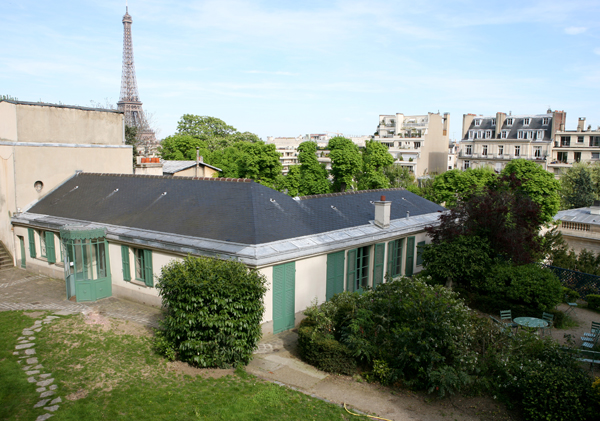Grand adepte de ses romans, j’ai eu le plaisir d’user les bancs de l’écoles en face de la Maison de Balzac, au cœur de l’ancien village de Passy.
 L’écrivain stakhanoviste y trouva refuge, de 1840 à 1847, avec sa gouvernante qui fut, aussi, sa maîtresse. Au fond de l’appartement, vous pouvez voir le tout petit bureau de Balzac dont l’étroitesse contraste avec le foisonnement de l’œuvre qui y a été créée. De ce lieu calme et isolé, à l’époque, Balzac pouvait aisément rejoindre le centre de Paris. Il avait également la jouissance du jardin où il cueillait, pour son épouse, le lilas et les premières violettes. Mais cette maison fut surtout un lieu de travail acharné. C’est dans son bureau que Balzac corrigea l’ensemble de la Comédie humaine et écrivit ses plus grands chefs d’oeuvre: Une ténébreuse affaire, La Rabouilleuse, Splendeurs et misères des courtisanes, La Cousine Bette, Le Cousin Pons…
L’écrivain stakhanoviste y trouva refuge, de 1840 à 1847, avec sa gouvernante qui fut, aussi, sa maîtresse. Au fond de l’appartement, vous pouvez voir le tout petit bureau de Balzac dont l’étroitesse contraste avec le foisonnement de l’œuvre qui y a été créée. De ce lieu calme et isolé, à l’époque, Balzac pouvait aisément rejoindre le centre de Paris. Il avait également la jouissance du jardin où il cueillait, pour son épouse, le lilas et les premières violettes. Mais cette maison fut surtout un lieu de travail acharné. C’est dans son bureau que Balzac corrigea l’ensemble de la Comédie humaine et écrivit ses plus grands chefs d’oeuvre: Une ténébreuse affaire, La Rabouilleuse, Splendeurs et misères des courtisanes, La Cousine Bette, Le Cousin Pons…

Outre l’appartement de l’écrivain, La Maison comprend diverses pièces qu’occupaient, à l’origine, d’autres locataires. Classée monument historique, elle accueille les objets personnels de l’écrivain dont sa cafetière ornée des initiales HB qui permettait de maintenir au chaud « l’excitant moderne » dont abusa l’auteur de La Comédie humaine. J’ai également été heureux d’examiner quelques célèbres portraits de l’écrivain, peintures, estampes, lettres autographes ainsi que des livres rares provenant de la bibliothèque personnelle de Balzac et plusieurs documents évoquant l’état de famine dans laquelle vécut souvent le romancier. Et puis, surtout, je vous recommande de voir la « généalogie des personnages de La Comédie humaine ». Elle est représentée sur un tableau long de 14,50 m où sont référencés 1000 personnages sur les plus ou moins 6000 que compte La Comédie humaine. Cette réalisation permet de mieux mesurer l’immensité de l’œuvre de Balzac. Enfin, une pièce est entièrement consacrée à Madame Hanska que l’écrivain épousa après dix-huit années de correspondance passionnée. Sacré bonhomme ! Allez donc visiter sa maison. Nous lui devons bien ce petit hommage, tant son œuvre pharaonique a nourri l’imagination de centaines de millions d’hommes et de femmes qui lui succédèrent sur le chemin de la vie.
Balzac the Prolific
As a great fan of his novels, I was delighted to rest awhile on the school benches opposite the Maison de Balzac, at the heart of the ancient village of Passy.
The hardworking writer found refuge here, from 1840 to 1847, with his governess who was also his mistress. At the back of the apartment, you can see Balzac’s tiny office, the miniscule dimensions of which contrast starkly with the abundance of work created there. In his day, Balzac could get to the centre of Paris in no time at all from this calm and isolated spot. He also loved the garden where he picked lilacs and the first violets for his wife. But above all this house was the setting for his tireless work. It was in his office that Balzac corrected the entire ‘Human Comedy’ collection and wrote his greatest masterpieces: Murky Business, The Black Sheep, A Harlot High and Low, Cousin Bette, Cousin Pons, etc.
As well as the writer’s apartment, the Maison de Balzac includes other rooms originally occupied by other tenants. The building is classed as a historic monument and displays some of the writer’s personal objects such as a coffee thermos bearing the initials HB which allowed him to keep the ‘modern stimulant’, that he drunk so much of, hot. I was also pleased to be able to examine a few famous portraits of the writer, paintings, etchings, autographed letters as well as rare books from Balzac’s private library and several documents indicating the state of famine that the author often lived. And then, above all, I recommend that you take a look at the ‘genealogy of the characters of the Human Comedy’. It is represented on a 14.5 metre-long board indicating 1000 characters from the more or less 6000 in total that the Human Comedy opus counts. This representation allows you to really get a measure of the immensity of Balzac’s work. Finally, a room is entirely devoted to Mrs. Hanska who the writer would marry after eighteen years of passionate correspondence. What a personality! So do go and visit this house. We definitely owe him this small homage, given how much his monumental work fed the imagination of hundreds of millions of men and women who followed him on the walk of life.
Maison de Balzac : 47, rue Raynouard
75016 Paris Métro: Passy, La Muette
Ouvert: 10h00 à 17h40 tous les jours sauf lundi.
Didier MOINEL DELALANDE






